The best purple flowering trees in Florida for your yard will depend on the local USDA hardiness zones. Florida is a warm state with mild winters, and many purple flowering trees hail from tropical climates. This means there’s plenty of choice! Florida’s USDA hardiness zones range from 8 to 11. Simply choose one that suits your region and water it well.
1. Crape Myrtle
Lagerstromia indica trees thrive in tropical conditions. This beauty is native to China and Japan, and its purple cultivar is the most attractive.
Crape myrtle produces distinctive crinkled flowers that resemble crape paper in late spring and early summer. It tolerates drought once established and draws in hummingbirds.
A great choice for Florida is the queen crape myrtle tree. This cultivar has large lilac-purple blooms and doesn’t drop its foliage in fall. It’s a handsome shade tree that feeds essential pollinators for months on end.
Queen crape myrtle reaches 30 feet, and it’s simple to prune shorter. Don’t cut crape myrtle back too harshly in the fall. These tropical trees need branches to generate new growth. Pruning to ground level weakens them so much that they may not survive a chilly winter.
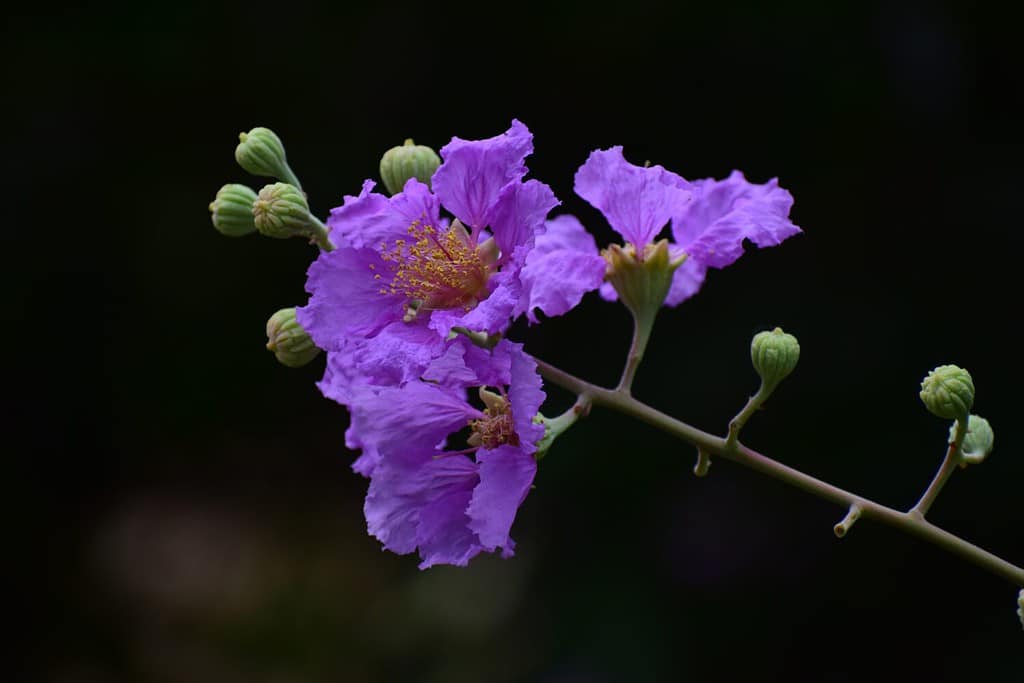
Crape myrtle trees are native to Japan and China.
©Manas Mistry/Shutterstock.com
2. Purple Rose of Sharon
Hibiscus Syriacus or mallow, whatever you choose to call it, is an easy-to-grow large purple, pink, blue, or white shrub that’s easily trained into a small tree. Within three years, a many-stemmed shrub can form a single-trunked 12-foot-tall tree with an eight-foot crown.
Best grown in USDA zones 5-9, this is a purple flowering tree for Florida’s north. Plant it in full sun, with free-draining soil, and it’ll bloom double flowers in summer from the first year. In cooler zones, it may lose leaves in winter, but in Florida’s hotter zones, it’s evergreen.
If you want a small row of purple flowering trees, cut the rose of Sharon back to a few feet tall in winter. It’ll regrow to around six feet the following year.
Ensure you pick out a purple version as the vast majority are pink!
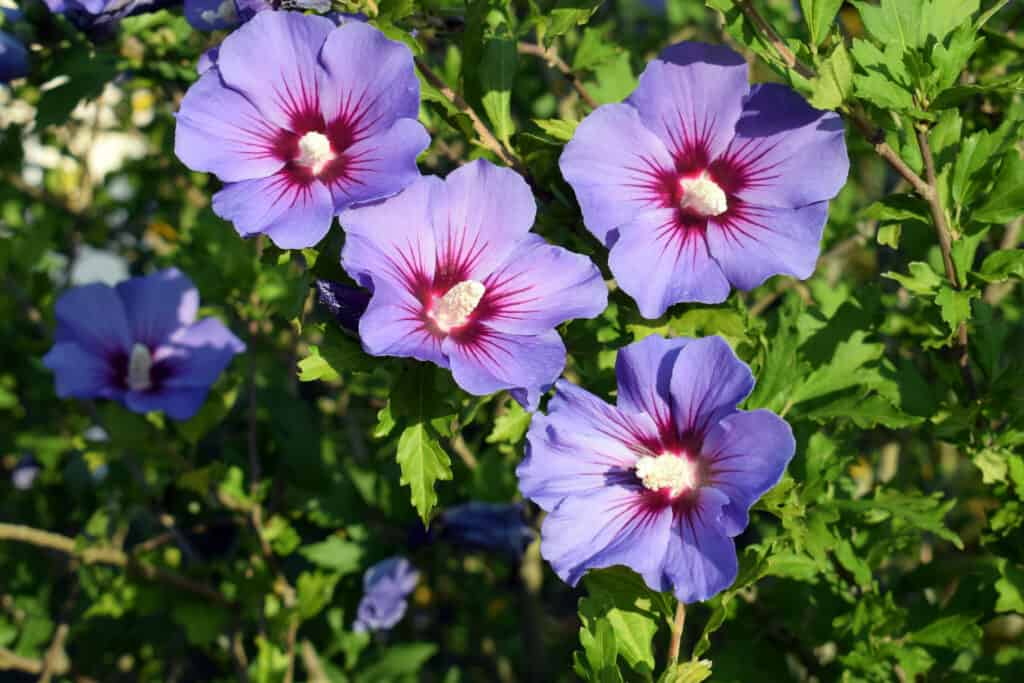
Rose of Sharon cultivars bloom red, pink, white, or purple in late summer.
©iStock.com/matunka
3. Jacaranda Tree
Purple-blooming jacaranda is a tropical tree that grows in Florida’s hot zones 9b to 11. It’s native to hot and humid South America and needs full sun to thrive.
Briefly deciduous, jacaranda trees sprout feathery new foliage in spring amid its immense purple flower clusters. Jacaranda flowers are truly spectacular, and hummingbirds love the trumpet-shaped purple blooms that burst out twice a year – once in spring and again in fall.
In perfect conditions, Florida’s iconic jacaranda reaches 50 feet tall and 15-13 feet in spread. It’s a show-stopper that’s coated with pollinators in bloom.

Iconic Florida jacaranda blooms purple flowers that hummingbirds adore.
©Alta Oosthuizen/Shutterstock.com
4. Takasago Flowering Cherry
Pruus seiboldii is a purple flowering tree in Florida, but it’s a native of China, Japan, and Korea.
This spectacular tree’s low crown sweeps the soil despite reaching 20 feet tall. Some folks think its flowers are more pink than purple, but there’s a fine line, and most garden centers describe the blooms as rose-pink or lilac purple. Either way, it’s a charismatic tree that’s so smothered in springtime blooms that its branches disappear. Like most cherry trees, foliage unfurls after the blooms are spent.
Takasago flowering cherry suits all well-drained soil types, especially chalk, and prefers full sun or part shade. Best grown in USDA zones 4-9, its compact size complements small yards or mixed flower borders.
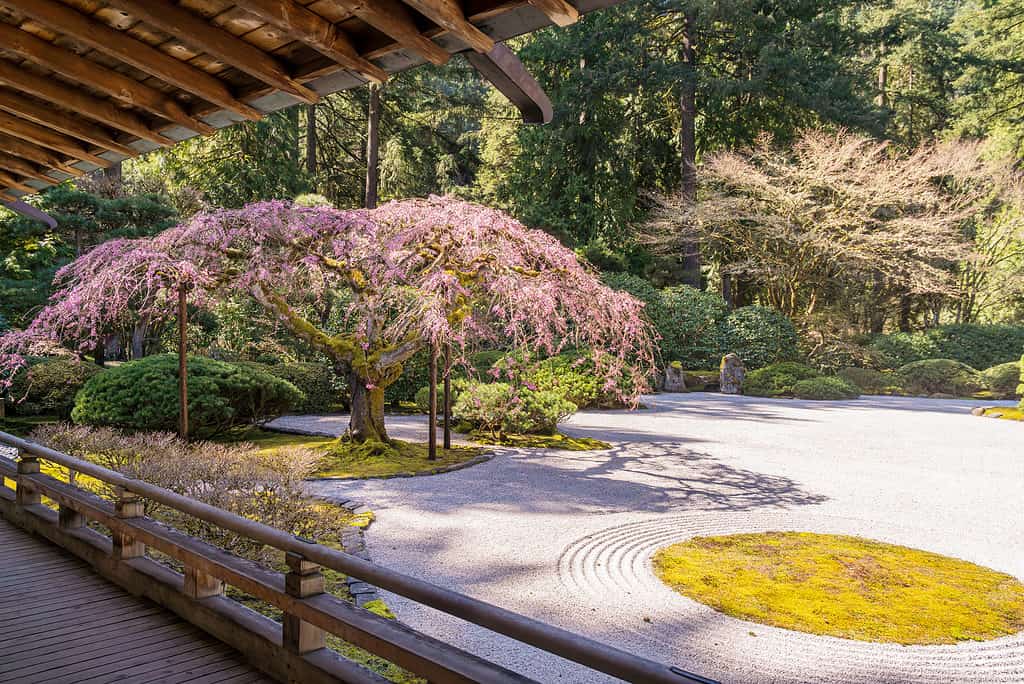
Takasago cherry’s crown is only around two feet off the ground.
©Michael Warwick/Shutterstock.com
5. Eastern Redbud
North American native Cercis canadensis is the eastern redbud tree. It blooms beautiful pinky-purple flowers in spring on its wide, deep-green canopy.
Standard eastern redbuds can reach 20-30 feet tall, but dwarf versions better suit small yards.
Plant eastern redbud in full sun or partial shade, and water it regularly. This beauty isn’t particularly drought-tolerant. It needs extra water in summer and does best in zones 4-9.
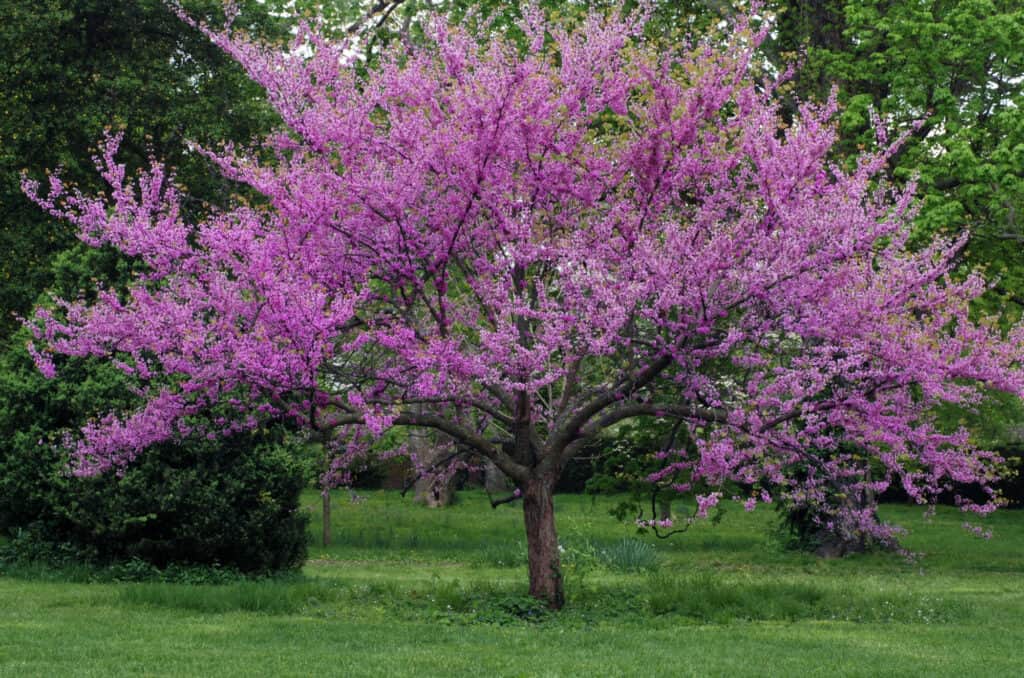
Eastern redbud trees reach up to 30 feet high and bloom in spring.
©Marie C Fields/Shutterstock.com
6. Royal Purple Smoke Tree
Deciduous royal purple smoke tree Cotinus coggygria originated from Holland. It displays burgundy-purple foliage in April and plumes of smoke-like pinky-purple flower sprays all summer.
This unique tree grows best up to USDA zone 9, so it’s suited to north Florida. It’s drought tolerant and enjoys full sun to partial shade.
This compact tree only reaches 15 feet maximum, so it’s a good choice for flower borders and compact yards.

Purple royal smoke tree’s fluffy flower spikes create an unusual display in Florida.
©Jared Quentin/Shutterstock.com
7. Texas Mountain Laurel Tree
Texan native mountain laurel is a tough evergreen tree that grows across Florida in rocky soil. It’s drought tolerant, reaching 15 feet tall by eight feet tall, and best of all, it blooms blue-purple flowers with stunning purple stripes.
Mountain laurel’s butterfly-shaped flowers emerge in late spring in a flat-topped cluster and last until early summer. It grows in full sun and full shade but prefers a combination of both in Florida’s hottest zones. You can use this handsome tree to create a thicket or privacy hedge.
Mountain laurel attracts pollinators and provides cover for birds. It’s a threatened species in Florida, so what better reason to grow one in your yard?
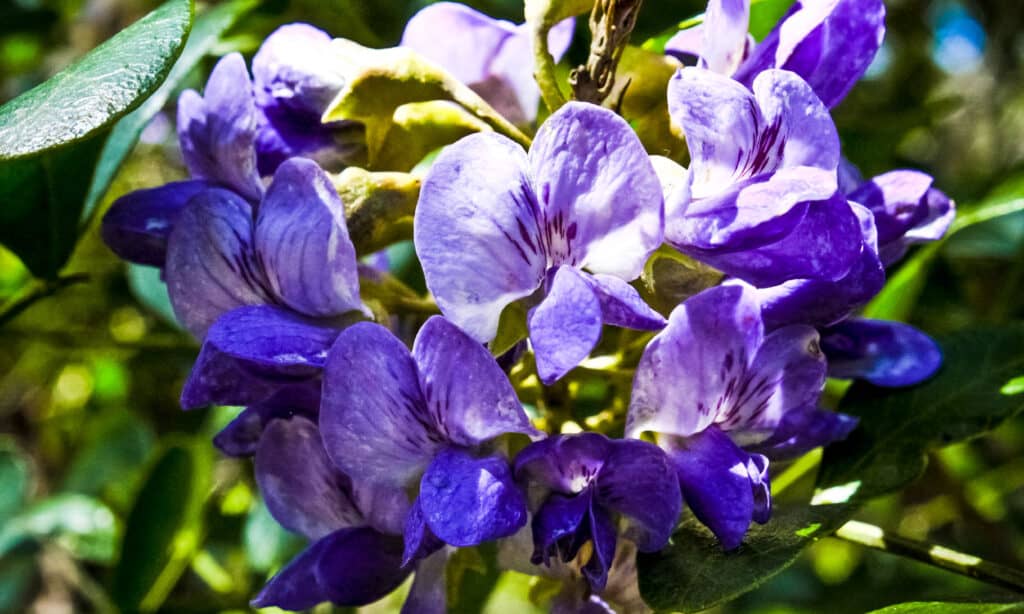
Mountain laurel is an evergreen with bell-shaped fragrant flowers.
©Dark Obsession Photography/Shutterstock.com
8. Chaste Tree
Vitex agnus castus is a large shrub that gardeners can train into a small tree in Florida. Its spikes of aromatic purple flowers bloom in late spring to early summer and bring all the bees to the yard.
It’s a drought-tolerant tree that loves full sun and fertile, well-drained soil. Although it grows best in soil, it also manages in a large, well-watered, and fed container.
Chaste tree grows in USDA zones 7b to 11, so it’s a handsome choice for all of Florida’s growing zones. It only reaches 10-15 feet tall, which is ideal for small yards and mixed flower borders.
Some folks even grow purple chaste trees on a sunny balcony. However, beware of its width. This purple flowering tree in Florida can stretch to over double its height – up to 30 feet! Trim it back after flowering to retain a manageable shape.
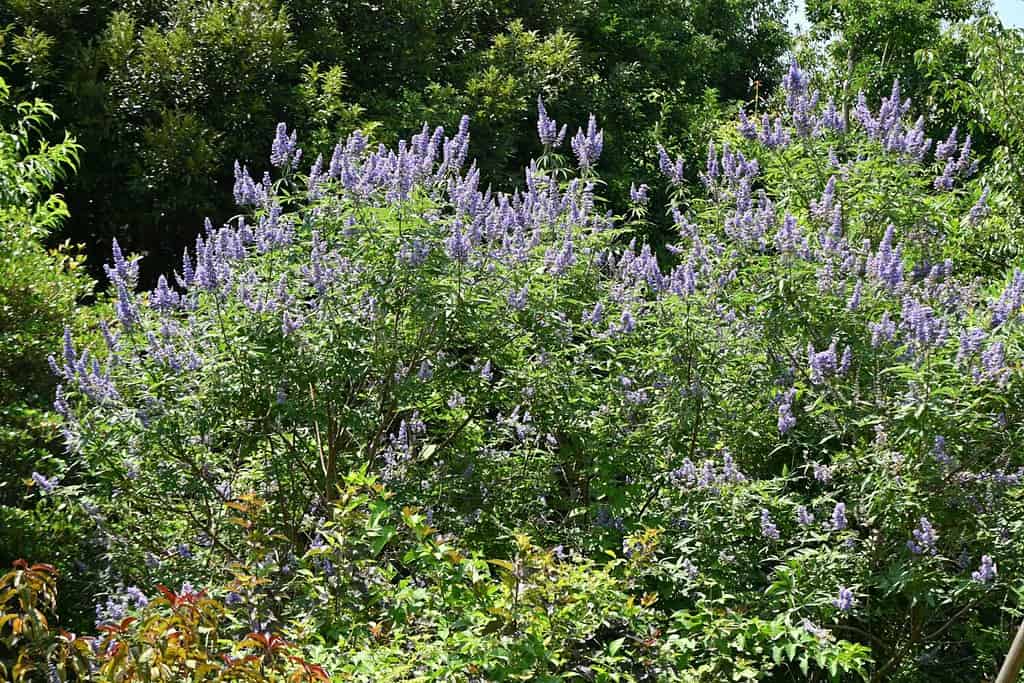
Chaste tree is a small shrub that’s easily trained into a small tree.
©tamu1500/Shutterstock.com
9. Desert Willow
This attractive tree is not actually a willow tree. It’s a western Texas and north Mexican desert tree that’s drought tolerant in Florida’s hot 10-11 USDA growing zones. It’s adopted the name willow due to its narrow, willow-like leaves.
Chilopsis linearis produces large trumpet-shaped lilac-purple flowers on a sturdy but delicate-looking crown throughout summer. It’s especially attractive to hummingbirds and one of the few trees that thrive in a container.
Desert willow reaches 15 to 40 feet and spreads over 15-25 feet depending on how much water it soaks up. If you container grows this attractive purple flowering tree in Florida, ensure it’s regularly watered, or its flowers fall off to conserve liquid.
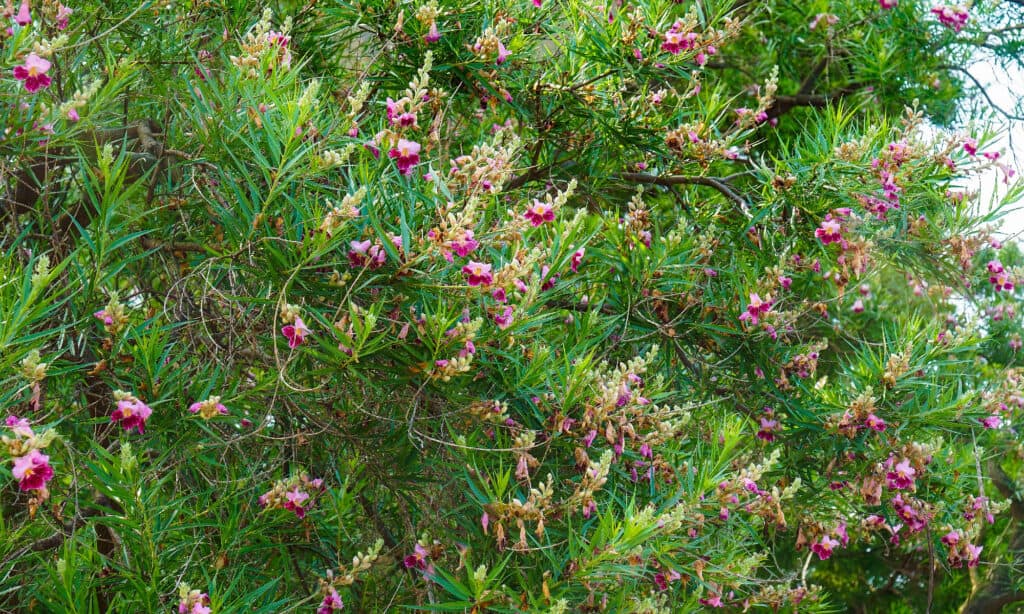
Desert willow is a drought tolerant desert tree with willow leaf shaped foliage.
©Nikolay Kurzenko/Shutterstock.com
10. Hong Kong Orchid Tree
Stunning tropical orchid trees are native to southwest Asia. They produce glorious clusters of orchid-like pinky-purple flowers that Floridians can’t get enough of. It’s a common sight in Florida’s growing zones 9-11. Some folks call this the butterfly tree because its blooms resemble flying six-inch wide butterflies from January to May.
Hong Kong orchid tree is mid-sized. It’ll reach 25 feet and spread across the same. Although it’s drought tolerant, young trees need lots of water to establish a strong root system. Thick, organic mulch or a specific tree fertilizer encourages blooming abundance in poor soil.
Alongside its huge purple flowers, Hong Kong tree boasts spectacular fall colors in cool zones. In tropical zones, it’s generally evergreen.
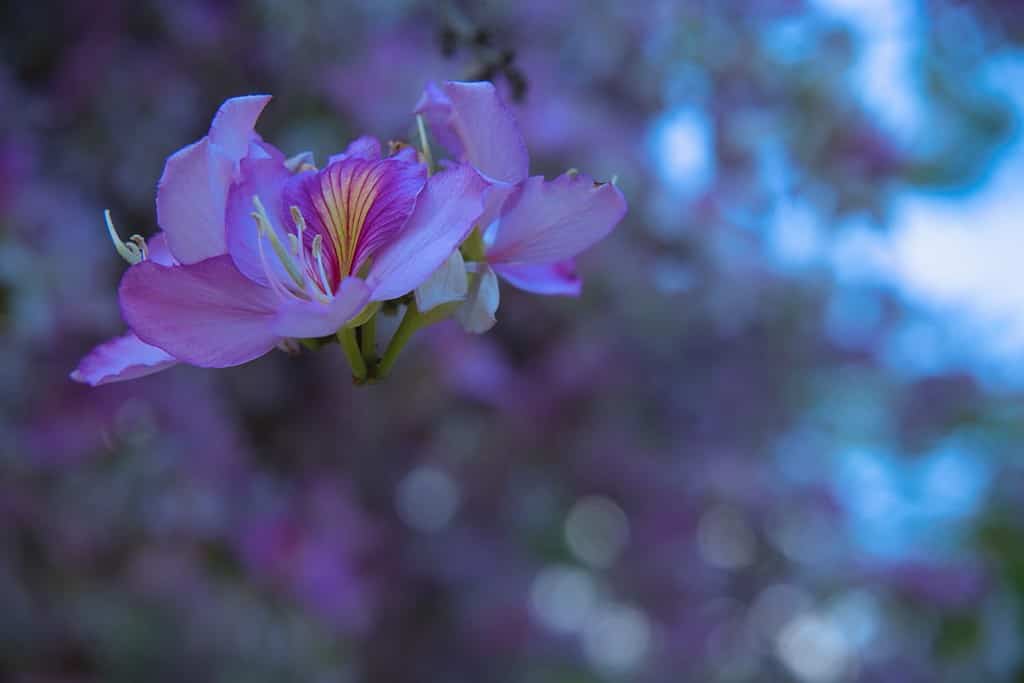
Orchid trees thrive in Florida, but they’re native to southwest Asia.
©Ruth Laguna/Shutterstock.com
11. Royal Empress Tree
Paulownia tomentosa is an Eastern Asia native, but popular in Florida for its vanilla-scented, light purple flower clusters throughout summer. It’s a many-named tree! Other names include Chinese empress tree, foxglove tree, or princess tree.
Fast-growing royal empress trees produce a thick clustering canopy of foliage and flowers, and it reaches 70 feet tall in ideal conditions. It prefers full sun to partial shade and best suits cooler Florida zones up to 9. In hotter zones, it needs a shadier spot.
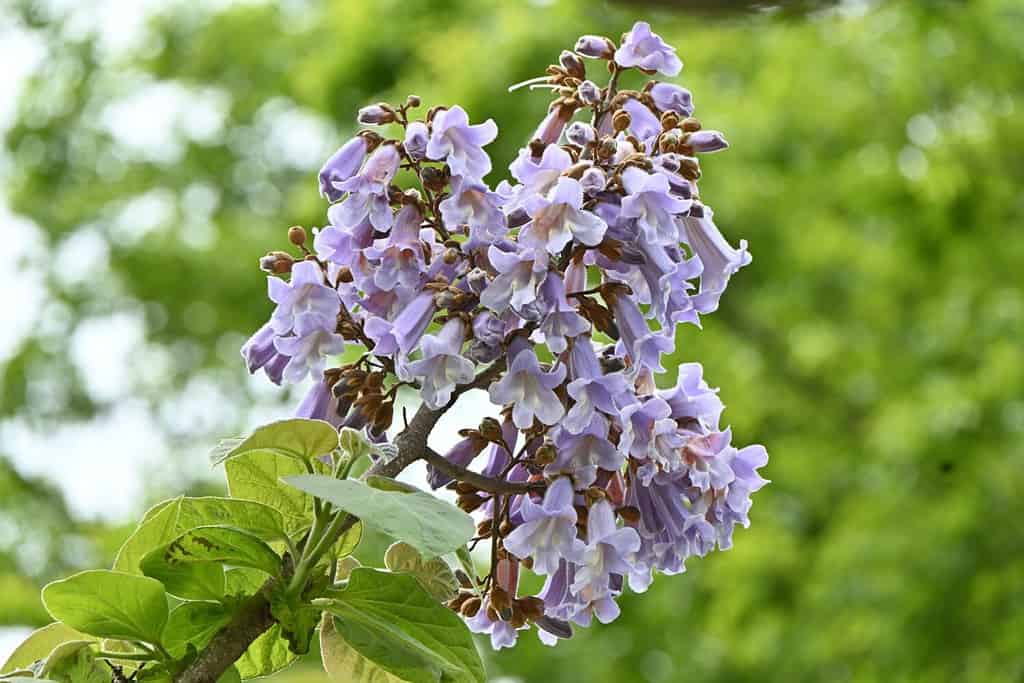
Royal empress tree is one of the world’s fastest growing trees.
©tamu1500/Shutterstock.com
The photo featured at the top of this post is © mauro halpern / Flickr – License / Original
Thank you for reading! Have some feedback for us? Contact the AZ Animals editorial team.






